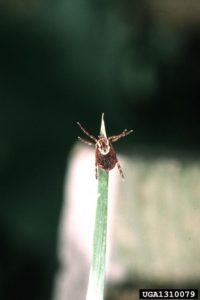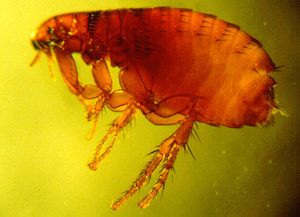By: Dr. Mike Merchant, Professor and Urban Entomologist
Fleas and ticks are not the kind of pests one normally expects to find in schools, but then what’s normal about school IPM? Several recent calls to our office have concerned flea and tick problems, some of which are apparently being brought from home, and some which may be originating on school grounds. So let’s learn some basics about these two pest types.
Fleas are insect pests of warm blooded animals. About 95% of flea species specialize in feeding on certain mammals, and only about 5% feed on birds. The most common flea encountered on people, dogs and cats is the cat flea, Ctenocephalides felis. Though cat fleas readily bite humans, they cannot survive and reproduce on human blood alone. Therefore, apart from the occasional flea that might be transported from a home, the presence of fleas in a school classroom indicates a furry host is nearby.
Most chronic flea problems in schools can be traced to feral dogs or cats, or the occasional opossum or raccoon that have taken up residence in a building crawl space or attic. In such cases, look critically at the structure to determine possible entry points, and the location of possible den sites. Live traps are usually the best way to remove unwanted boarders. Potential entry points should be closed up as soon as the suspected animals are removed. Rats and other rodents can also harbor fleas, but rat fleas are less likely to be a biting problem for people.

This American Dog tick (Dermacentor variabillis) is found on a grass blade. Most commonly referred as questing. Image from Jim Occi, BugPics, Bugwood.org
Ticks are most often picked up outdoors. Ticks can hitchhike for several days in the hair or on hard-to-see parts of the body, so finding a tick on a teacher or student is not certain proof that the tick was picked up at school. Playgrounds that border on natural prairies, un-mowed fields or the edges of forests may be a source of ticks.
Ticks typically hitch rides on the shoes, socks, or pants legs of people when they walk through suitable tick habitat. Ticks may wander and climb over the body of their potential host for several hours before attaching. The idea that ticks climb into trees to drop on unsuspecting children or adults underneath is not true, though ticks are frequently found attached to the head amidst the hair. These ticks simply climbed, unnoticed, from the lower body to the head before attaching.
Numerous ticks in a classroom is rare, but if they occurred, it would signal the presence of a nearby tick-infested dog. The brown dog tick is the only tick species that is normally found indoors and its sole hosts are dogs. If the infested dog is a pet, it should be removed from the school and treated immediately by a qualified vet. If the infestation appears to be coming from a crawl space or den under a portable classroom, the insecticide permethrin, or similar registered Yellow-Category product, can provide control. Be sure to spray vertical as well as horizontal surfaces, since ticks typically climb a vertical walls to rest after a blood meal.
Outdoor tick infestations can be suppressed to some extent by mowing grass where it is suspected that children might be picking up the ticks—say along edges of sidewalks or playgrounds. If further actions are needed, permethrin can provide extended suppression of ticks along the edges of grassy or brushy sites.
For more information on fleas and ticks, see online publications E-433 Controlling Fleas or E-150 Control Those Ticks and in Spanish E-150S: El Control de Garrapatas
We have the best mobile website on ticks http://tickapp.tamu.edu/
Insect growth regulators, such as Precor® or NyGard®, are effective Green-category products for flea control indoors, particularly in carpets and along floor edges and under buildings. Sprays should be directed to sites where animals are suspected to hide or rest during the day. Keep in mind that most IGRs kill flea larvae, but not adult fleas. Sprays containing limonene or pyrethrins are effective Green-category products that can knock down and kill adult fleas, but they may need repeated applications over 1-2 weeks for a well-established flea problem. Underneath a building, a longer-residual product, like permethrin, may be needed.
Insect growth regulators in today’s pesticide market are man-made versions of compounds that are very similar to insect hormones. The concept of using insect hormones was first discovered by researchers studying insect metamorphosis in the late 1950s. The first insect hormone to be discovered was referred to as “juvenile hormone” (JH) because of its action in keeping insects in the immature state. It was noticed that when JH was applied to some immature insects, like Cecropia moth caterpillars, they could be kept almost indefinitely in the caterpillar stage. Here was the fountain of youth, or as one researcher put it, a “Peter Pan hormone”.
It was quickly discovered that even small amounts of some juvenile hormone mimics applied to the cuticle of developing insects could also disrupt normal metamorphosis, causing them to die without completing development. Surely this would be “a truly perfect insecticide, for the insects could hardly evolve a resistance to their own hormones,” reasoned one early JH researcher.
Several commercially successful hormone-mimicking insecticides have been developed over the years. Though perhaps not the perfect, all-around insecticides originally envisioned, they have proven to be successful tools for the management of certain pests. In addition, these “IGRs”, as they came to be known, proved to be generally very low in acute toxicity to mammals and birds, groups that share no similar hormone systems with insects.
Under the current Texas school IPM regulations, IGR products may be applied to schools without needing to file a use-Justification form with the IPM Coordinator. This means that an applicator or licensed technician can apply an IGR during an inspection, whenever he or she deems it appropriate, providing they follow the 48-hour indoor posting rule. Effective IGR products include fire ant baits, flea and cockroach sprays, termite baits, some ant baits, and mosquito Larvicides. There are also excellent IGRs for the control of whiteflies, aphids, scales, and fungus gnats infesting outdoor and indoor plants.
Juvenile hormone-mimics work by disrupting the metamorphosis process. JH-compounds work principally on immature stages and are generally slow to produce a pest control effect. They are generally non-toxic to adult stages, but can be quite effective in killing immature insects and sterilizing adults. Examples:
- methoprene
- Extinguish® (fire ants)
- Precor®, Archer® (fleas)
- Pharorid™ (ants)
- Altosid®, PreStrike™ (mosquitoes)
- Award ® (fire ants)
- Apex® (fungus gnats)
- hydroprene
- Gencor®, Point Source™ (cockroaches)
- pyriproxifen
- Nylar®, Nygard® (fleas, cockroaches)
Product names do indicate endorsement of a certain product but are included for educational purposes.


 .
.